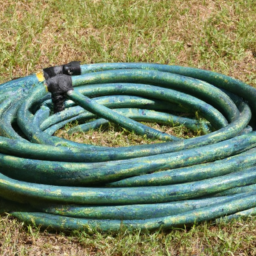Gallons per Minute Garden Hose
Table of Contents []
How Many Gallons Per Minute Garden Hose
Introduction
Do you know how many gallons per minute (GPM) are coming out of your garden hose? If you're curious, you're in the right place! In this article, we'll discuss the following 8-12 topics, relevant to the question How Many Gallons Per Minute Garden Hose? The 8-12 topics, in logical sequence, will be as follows:
1) What is a Garden Hose?
2) What is GPM?
3) Calculating the Flow Volume of a Garden Hose
4) Factors That Affect the Speed of Water Through a Garden Hose
5) Calculating GPM From Your Garden Hose
6) Common GPM Flow Volumes for Garden Hoses
7) Calculating Gallons Used From GPM
8) Troubleshooting Low-Flow Issues
9) Using a Hose Flow Meter
10) Running Multiple Garden Hoses at the Same Time
11) Winterizing a Garden Hose
12) Summarizing the Benefits and Necessities of a Garden Hose
Now, we'll dive into each of these topics with some further detail.
What is a Garden Hose?
Before we discuss the flow rate of a garden hose, let's quickly review what a garden hose is and its various parts. A garden hose is a flexible hose planted in gardens to water plants, rinse cars or furniture, or fill up pools. It's commonly made out of rubber and is usually available in various lengths. Its parts include a hose female connector, a water shut-off valve, a hose washer, a nozzle, a male connector, a hose clamp, and a hose cap.
What is GPM?
So what is GPM and why is it important when discussing garden hoses? GPM stands for gallons per minute. It is a measure of water flow and expresses the volume of water flowing through an object per minute. It is commonly used when discussing water pressure.
Calculating the Flow Volume of a Garden Hose
When a garden hose has a specific GPM, this means that the water output is a certain volume each minute. Calculating the flow volume of a garden hose involves using a circular, cylindrical surface area formula. This involves using pi, often approximated to 3.14, to calculate the area of a cylinder.
Factors That Affect the Speed of Water Through a Garden Hose
The speed of water through a garden hose is changed based on the length of the hose, the water pressure, the material of the hose, and whether or not it is kinked. Longer hoses have a reduced GPM because the water has a longer distance to travel. Lower water pressure means the GPM is reduced and sometimes an increase in the width of the hose is required to maintain the desired flow. Kinked, torn, or cracked hoses should be replaced in order to ensure the desired flow rate is maintained.
Calculating GPM From Your Garden Hose
When discovering the GPM for your garden hose, use a bucket to time how fast it fills. Divide the number of gallons the bucket holds by the time it takes to fill, and you will get the GPM.
Common GPM Flow Volumes for Garden Hoses
Common GPM flow volumes and PSI (pounds per square inch) ratings for garden hoses vary based on the construction of the hose. While most standard garden hoses have a GPM of around 2-5, some special types of hoses may have a GPM as high as 160.
Calculating Gallons Used From GPM
Now that you know the GPM of the water flowing through the garden hose, you can calculate how much total water you will use. For example, if you have a 4 gallon bucket and you know the GPM, you can simply multiply the two numbers together: 4 GPM times 4 gallons. This will tell you that you will use 16 gallons of water.
Troubleshooting Low-Flow Issues
If you're experiencing a low water flow, you should first check the water pressure. Low water flow could indicate a clogged or blocked hose or a free-flowing connection, or if the GPM is lower than expected, you should inspect the hose for any obstruction or for a sudden decrease in diameter.
Using a Hose Flow Meter
If you want to measure the flow rate of the hose more accurately without running your own experiments, a hose flow meter can be an invaluable tool. This device measures the exact GPM through your garden hose and eliminates the need to guess.
Running Multiple Garden Hoses at the Same Time
If you're running multiple hoses at the same time, you'll need to calculate the GPM for all the hoses and then total them together. Doing this ensures the water pressure is adequate and that no single hose is being overtasked.
Winterizing a Garden Hose
Before the winter months, it is essential to properly winterize your garden hose. This includes draining the water inside, ensuring it is not connected to an exterior faucet, and storing it carefully. This ensures the garden hose does not become malformed or damaged over the winter months.
Summarizing the Benefits and Necessities of a Garden Hose
Garden hoses are an integral part of any yard and garden space. They are incredibly handy for any kind of cleaning, watering, or other tasks that require water. With a garden hose, you can get your work done quickly and accurately and the GPM understanding discussed above helps you know how much water is flowing through the hose.
Final Thoughts
We hope this article served as a good introduction to the concept of GPM as it relates to your garden hose. Understanding the GPM can help you ensure the effectiveness of your garden hose and make the most of its use. Above all else, remember to take active measures to ensure your garden hose works correctly and efficiently.
Thanks for reading this article on How Many Gallons Per Minute Garden Hose. We hope you now have a better understanding of GPM and what to consider when trying to calculate it for your garden hose.

Previous Page
